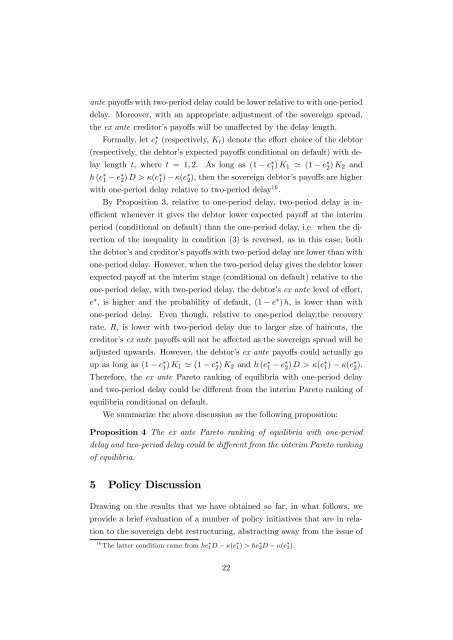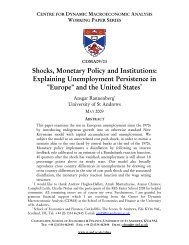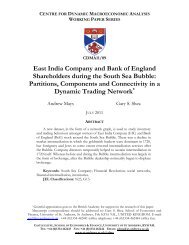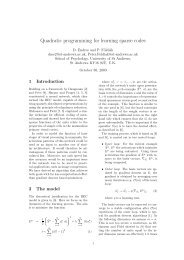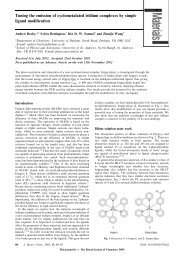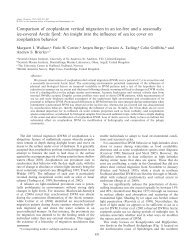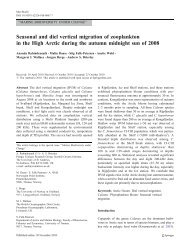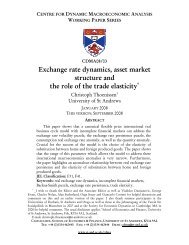Delay and Haircuts in Sovereign Debt - University of St Andrews
Delay and Haircuts in Sovereign Debt - University of St Andrews
Delay and Haircuts in Sovereign Debt - University of St Andrews
Create successful ePaper yourself
Turn your PDF publications into a flip-book with our unique Google optimized e-Paper software.
ante payo¤s with two-period delay could be lower relative to with one-period<br />
delay. Moreover, with an appropriate adjustment <strong>of</strong> the sovereign spread,<br />
the ex ante creditor’s payo¤s will be una¤ected by the delay length.<br />
Formally, let e t (respectively, K t ) denote the e¤ort choice <strong>of</strong> the debtor<br />
(respectively, the debtor’s expected payo¤s conditional on default) with delay<br />
length t, where t = 1; 2. As long as (1 e 1 ) K 1 ' (1 e 2 ) K 2 <strong>and</strong><br />
h (e 1 e 2 ) D > (e 1 ) (e 2 ), then the sovereign debtor’s payo¤s are higher<br />
with one-period delay relative to two-period delay 16 .<br />
By Proposition 3, relative to one-period delay, two-period delay is <strong>in</strong>e¢<br />
cient whenever it gives the debtor lower expected payo¤ at the <strong>in</strong>terim<br />
period (conditional on default) than the one-period delay, i.e. when the direction<br />
<strong>of</strong> the <strong>in</strong>equality <strong>in</strong> condition (3) is reversed, as <strong>in</strong> this case, both<br />
the debtor’s <strong>and</strong> creditor’s payo¤s with two-period delay are lower than with<br />
one-period delay. However, when the two-period delay gives the debtor lower<br />
expected payo¤ at the <strong>in</strong>terim stage (conditional on default) relative to the<br />
one-period delay, with two-period delay, the debtor’s ex ante level <strong>of</strong> e¤ort,<br />
e , is higher <strong>and</strong> the probability <strong>of</strong> default, (1<br />
one-period delay.<br />
e ) h, is lower than with<br />
Even though, relative to one-period delay,the recovery<br />
rate, R, is lower with two-period delay due to larger size <strong>of</strong> haircuts, the<br />
creditor’s ex ante payo¤s will not be a¤ected as the sovereign spread will be<br />
adjusted upwards. However, the debtor’s ex ante payo¤s could actually go<br />
up as long as (1 e 1 ) K 1 ' (1 e 2 ) K 2 <strong>and</strong> h (e 1 e 2 ) D > (e 1 ) (e 2 ).<br />
Therefore, the ex ante Pareto rank<strong>in</strong>g <strong>of</strong> equilibria with one-period delay<br />
<strong>and</strong> two-period delay could be di¤erent from the <strong>in</strong>terim Pareto rank<strong>in</strong>g <strong>of</strong><br />
equilibria conditional on default.<br />
We summarize the above discussion as the follow<strong>in</strong>g proposition:<br />
Proposition 4 The ex ante Pareto rank<strong>in</strong>g <strong>of</strong> equilibria with one-period<br />
delay <strong>and</strong> two-period delay could be di¤erent from the <strong>in</strong>terim Pareto rank<strong>in</strong>g<br />
<strong>of</strong> equilibria.<br />
5 Policy Discussion<br />
Draw<strong>in</strong>g on the results that we have obta<strong>in</strong>ed so far, <strong>in</strong> what follows, we<br />
provide a brief evaluation <strong>of</strong> a number <strong>of</strong> policy <strong>in</strong>itiatives that are <strong>in</strong> relation<br />
to the sovereign debt restructur<strong>in</strong>g, abstract<strong>in</strong>g away from the issue <strong>of</strong><br />
16 The latter condition came from he 1D (e 1) > he 2D (e 2).<br />
22


